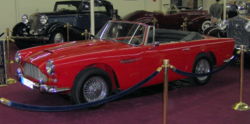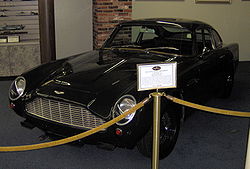
Aston Martin DB4
Encyclopedia
The DB4 is a sports car
Sports car
A sports car is a small, usually two seat, two door automobile designed for high speed driving and maneuverability....
sold by Aston Martin
Aston Martin
Aston Martin Lagonda Limited is a British manufacturer of luxury sports cars, based in Gaydon, Warwickshire. The company name is derived from the name of one of the company's founders, Lionel Martin, and from the Aston Hill speed hillclimb near Aston Clinton in Buckinghamshire...
from 1958 until 1963. It was an entirely different car from the DB Mark III
Aston Martin DB Mark III
The DB Mark III is a sports car sold by Aston Martin from 1957 through 1959. It was an evolution of the DB2/4 Mark II model it replaced, using an evolution of that car's W.O...
it replaced, though the 3.7 L engine was externally visually related to the 2.9 L unit found in that car.
The DB4's unique design and performance would later form the basis for future Aston Martin classics, such as the DB4 GT Zagato
Aston Martin DB4 GT Zagato
The Aston Martin DB4 GT Zagato was introduced in October 1960 at the London Motor Show. It was effectively a DB4 GT, lightened and improved by the Zagato factory in Italy, by Ercole Spada. Initially the factory had plans to produce 25 cars, but demand wasn't as strong as expected and production...
, the Lagonda Rapide
Lagonda Rapide
The Lagonda Rapide was a 4-door GT car produced from 1961 until 1964. Based on the Aston Martin DB4, it was David Brown's attempt to revive the Lagonda marque which he had purchased in 1948. It marked a revival of the Rapide model name which had been used by Lagonda during the 1930s...
4-door saloon, and its ultimate replacement the Aston Martin DB5
Aston Martin DB5
The Aston Martin DB5 is a luxury grand tourer that was made by Aston Martin. Released in 1963, it was an evolution of the final series of DB4. The DB series was named honouring David Brown ....
.
Design
The lightweight superleggeraSuperleggera
Superleggera is an automobile chassis construction technology developed by Felice Bianchi Anderloni of Italian coachbuilder Carrozzeria Touring. The company was located just north of Milan, near Alfa Romeo, Italian Citroen, and the former Isotta-Fraschini plant...
(tube-frame) body was designed by Carrozzeria Touring
Carrozzeria Touring
Carrozzeria Touring is an automobile coachbuilder established on March 25, 1926 in Milan, Italy by Felice Bianchi Anderloni and Gaetano Ponzoni...
in Milan, and its Continental looks caused a sensation on its unveiling at the 1958 London Motor Show. Although the design and construction techniques were Italian, the DB4 was the first Aston to be built at the company's Newport Pagnell
Newport Pagnell
Newport Pagnell is a town in the Borough of Milton Keynes , England. It is separated by the M1 motorway from Milton Keynes itself, though part of the same urban area...
works in Buckinghamshire
Buckinghamshire
Buckinghamshire is a ceremonial and non-metropolitan home county in South East England. The county town is Aylesbury, the largest town in the ceremonial county is Milton Keynes and largest town in the non-metropolitan county is High Wycombe....
, England.
Specifications
The 3.7 L (3670 cc/223 in³) engine, designed by Tadek MarekTadek Marek
Tadeusz "Tadek" Marek was a Polish automobile engineer, known for his Aston Martin engines.Marek was from Krakow.He raced and won with a Chevrolet Master sedan in the XII Rally Poland before moving to Great Britain...
, was a dual overhead cam straight-6
Straight-6
The straight-six engine or inline-six engine is a six-cylinder internal combustion engine with all six cylinders mounted in a straight line along the crankcase...
, with cylinder head
Cylinder head
In an internal combustion engine, the cylinder head sits above the cylinders on top of the cylinder block. It closes in the top of the cylinder, forming the combustion chamber. This joint is sealed by a head gasket...
and block
Cylinder block
A cylinder block is an integrated structure comprising the cylinder of a reciprocating engine and often some or all of their associated surrounding structures...
of cast R.R.50
Hiduminium
The Hiduminium or R.R. alloys are a series of high-strength, high-temperature aluminium alloys, developed for aircraft use by Rolls-Royce before World War II. They were manufactured and later developed by High Duty Alloys Ltd....
aluminium alloy. The engine was prone to overheating initially, but the 240 hp (179 kW) produced by the twin-SU carburettor version made buyers forgive this unfortunate trait. Servo assisted Disc brake
Disc brake
The disc brake or disk brake is a device for slowing or stopping the rotation of a wheel while it is in motion.A brake disc is usually made of cast iron, but may in some cases be made of composites such as reinforced carbon–carbon or ceramic matrix composites. This is connected to the wheel and/or...
s were fitted all around, with early 11.5 in (292 mm) Dunlop
Dunlop Tyres
Dunlop Tyres is a British company owned 75% by Goodyear Tire and Rubber Company and 25% by Sumitomo Rubber Industries, which bought the right to sell Dunlop-branded road tyres....
s being replaced by Girlings. The independent front suspension used ball-jointed wishbones and coil springs and the live rear axle also using coils springs with location by a Watt's linkage
Watt's linkage
Watt's linkage is a type of mechanical linkage invented by James Watt in which the central moving point of the linkage is constrained to travel on an approximation to a straight line...
. Rack and pinion steering was used. There was a choice of final drive ratios, the normal one for British and European use was 3.54:1, the United States usually got a 3.77:1 and a 3.31:1 was also available for customers wanting a car with an especially high top speed.
Performance
A car with the British standard 3.54 final drive ratio tested by The MotorThe Motor (magazine)
The Motor was a British weekly car magazine founded on 28 January 1903....
magazine in 1960 had a top speed of 139.3 mph (224.2 km/h) and could accelerate from 0-60 mph (96.6 km/h) in 9.3 seconds. A fuel consumption of 17.7 mpgimp was recorded. The test car cost £3967 including taxes.
"Series" DB4s
There were five "series" of DB4s, with the most visible changes being the addition of window frames in Series II and the adoption of a barred (rather than eggcrate) grille in Series IV. The Series V cars of September 1962 have a taller and longer body to provide more interior space, though the diameter of the wheels was reduced to keep the overall height the same. The front of the Series V was updated with a more aerodynamic look that was later carried over to the DB5 cars.DB4 Convertible

Convertible
A convertible is a type of automobile in which the roof can retract and fold away having windows which wind-down inside the doors, converting it from an enclosed to an open-air vehicle...
was introduced in 1962. It featured in-house styling similar to the Touring saloon, and an extremely rare factory hardtop
Hardtop
A hardtop is a term for a rigid, rather than canvas, automobile roof. It has been used in several contexts: detachable hardtops, retractable hardtop roofs, and the so-called pillarless hardtop body style....
was also available. In total, 70 DB4 convertibles were made from a total DB4 production run of 1110 cars. Top speed was about 136mph.
DB4 GT
The DB4 GT was a special lightweight, high-performance version of the DB4. Introduced in September, 1959, the GT's featured enclosed headlights and a thinner aluminium skin for lighter weight. The wheelbase was also reduced in comparison to the standard car, which resulted in many cars not being fitted with rear seats.The engine, though, was what made the GT special. Available in 3.7 L (3670 cc/223 in³) and 3.8 L (3750 cc/228 in³) versions, the GT's engine had twin sparkplugs per cylinder with two distributors and three twin-choke Weber carburettors. Modifications to the cylinder head brought compression to 9.0:1 and power output was 302 hp (225 kW). Maximum speed for the GT was 151 mph (246 km/h) with a 6.1 second sprint to 60 mph (97 km/h).
Seventy-five GTs were built with this body style. Nineteen more were modified by the Zagato works in Italy into DB4 GT Zagato
Aston Martin DB4 GT Zagato
The Aston Martin DB4 GT Zagato was introduced in October 1960 at the London Motor Show. It was effectively a DB4 GT, lightened and improved by the Zagato factory in Italy, by Ercole Spada. Initially the factory had plans to produce 25 cars, but demand wasn't as strong as expected and production...
s, with plain oval grilles, sans the stock GT's tail fins, and a smoothed out rear end. A single car was also styled by Bertone and dubbed the Bertone Jet.
Vantage
With the introduction of the Series IV in 1961, a high-performance DB4 Vantage was also offered. It featured three SU carbs and special cylinder heads, increasing power to 266 hpHorsepower
Horsepower is the name of several units of measurement of power. The most common definitions equal between 735.5 and 750 watts.Horsepower was originally defined to compare the output of steam engines with the power of draft horses in continuous operation. The unit was widely adopted to measure the...
(198 kW). Most Vantage models also used the enclosed headlights of the DB4 GT as well. In all, there were 136 saloons and 32 convertible
Convertible
A convertible is a type of automobile in which the roof can retract and fold away having windows which wind-down inside the doors, converting it from an enclosed to an open-air vehicle...
s with the Vantage engine.
Vantage GT

External links
- Aston Restoration Website – A site devoted to information on restoring an Aston Martin, including DB4
- Original Aston Martin brochures – Original sales literature for Aston Martin viewable online, including the DB4

